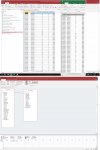A query from one of our software databases shows quantity of items pulled from inventory known as a counter-release. However, the report is showing both the quantity that was released, as well as the quantity that was re-stocked into the inventory because it was no longer used, or the counter-return. The counter-return is being shown as a negative number, which is helpful because it differentiates the two. This is also being shown in the same column. If they were in different columns I could do total the difference, but everything is vertical to each other. This information isn't very helpful as I need the amount that was released and used. I'm limited to the two fields and and the front end doesn't offer a field for showing only the amount that was released and not returned.
Is there a way I can somehow show the difference between these two fields showing the actual amount of parts that were taken and kept from the stock?
Is there a way I can somehow show the difference between these two fields showing the actual amount of parts that were taken and kept from the stock?


